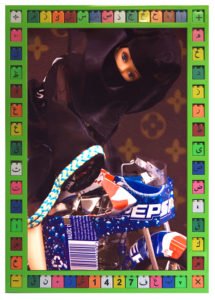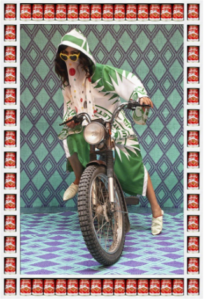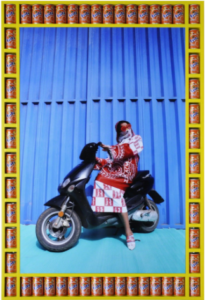CROSS-CULTURAL DIALOGUE: Munika on Coke
The discussion in one of my recent classes on cross-cultural dialogue and the politics of representation, both intimately interwoven into location-specific gender narratives, made me think of a binary approach to popular culture and art by some Muslim artists who are of the community they describe and have been educated in the West. Within anthropology, this approach would touch upon "indigenous anthropological" research category, as the academic would be of the community he/she describes with a Western-style education as the background to the research.
In this particular blogpost, I will focus on a Marrakesh-born and London-based artist, Hassan Hajjaj, who attempts to describe the story of ordinary women of Morocco and bridge the cultural gap between the West and the East through his “Kesh Angels” photography collection. What I see as peculiar in his approach to art is the way he attempts to break gender and class stereotypes and paint a picture of a particular location in the East by breaking the frame it has been gazed at by the West.
The effectiveness of cross-cultural dialogue is quite important in impacting different audiences, especially the ones that are framed as being opposite to one another in structure. The authentic, indigenous experience that the artist depicts plays a key role in unravelling the stereotypes of the East in the West. This is where I want to highlight Hajjaj's work as attempting to change the stereotypical perception of the West toward particular locations of the East. This is important, as the society Hajjaj comes from, Morocco in this particular case, represents much more than it has been described as in the West. Hajjaj forces his audiences to observe the nuances in the Moroccan community that have not been present in artistic mainstream depictions of Morocco earlier on. He builds his artistic career on this concept.
The video below provides an explanation and a theoretical background to Hajjaj’s project with the women of Marrakesh and the reasons why he chose to depict them as colorful, radiant and strong as they sit and pose on motorbikes.
From the video, one can infer that these are ordinary women Hajjaj uses in his work. They attempt to add color and vibrancy into the project in order to break the stereotypes they been put into. The vibrancy and color of their clothes, usually worn inside the home, contributes to a physical break from Western-imposed stereotypes of Eastern women.
Hassan Hajjaj, as someone who has the personal background of the East and the educational and artistic background of the West, tackles the stereotypes of women of Morocco through his most famous photography series “Kesh Angels” where he tells the story of ordinary henna artists. As a self-taught artist who drew elements of consumerism and the modern popular culture from the streets of London, Hajjaj shapes new bridges in rediscovering his own culture through a semi-lens of his new (Western) culture. What is important to note and what I found particularly striking is both the self-discovery he undergoes through this project and a new depiction and branding of Moroccan women in the West. The attempt to change the narrative is, therefore, two-fold.
One example of a daring narrative can be seen in one of his photographs titled “Munika on Coke”.

Munika on Coke
"Munika on Coke" by Hassan Hajjaj
The mere title of the photograph speaks volumes on what to expect when examining the nuances in it. Imagine a fully covered Moroccan woman on a bike posing with power and vibrancy in color! I had fun quietly examining such a photograph, as it represents an ordinary woman who actually uses a motorbike to ride around Marrakesh and draw henna in her daily life as a form of earning a living. Obviously, the photograph makes a grand exaggeration of such a life, but what makes it interesting is that one would not expect such a woman to even know how to ride a motorbike, let alone use it in daily life OR pose on it for a photographer.
To an extent, Hajjaj is a cultural ambassador who argues for a change of frames both literally and figuratively. His photographs exude color and energy, however the frames he circles them with are equally important as a critique to Western consumerism and consumerist prejudice the West has toward the East. This narrative transcends the one of stereotyping Eastern women, which is why I found his art quite fascinating.
I listened to his speech during an art exhibition in Abu Dhabi a couple of years back and fell in love with the way he tries to bridge two forms of artistic expression by morphing gender stereotyping, and the politics of representation and location into his work.
Some other photographs from his “Kesh Angels” collection include:

M
"M" by Hassan Hajjaj

Khadija
"Khadija" by Hassan Hajjaj
The mere fact that these women bring color into their ordinary lives, pose on motorbikes that they actually drive in real life and reveal their ankles breaks many stereotypes and speaks about the fluid nature of female identity that is yet to be fully discovered by the West. Perhaps it might be a coincidence, but the fact that one photograph is named "Khadija" might be religiously significant as well.
Super post